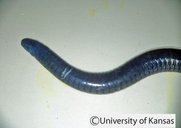|
Caecilia nigricans Boulenger, 1902
Rio Lita Caecilian | family: Caeciliidae genus: Caecilia |
| Species Description: Boulenger, G. A. 1902. Descriptions of new batrachians and reptiles from north western Ecuador. Annals and Magazine of Natural History, Series 7, 9: 51–57. | |
|
Etymology: The species epithet, “nigricans,” is a Latin word meaning black. |
|
 © 2010 Division of Herpetology, University of Kansas (1 of 2) |
|
|
|
Description While many characteristics among Caecilia are shared, C. nigricans has a distinct bluish coloration (Savage and Wake 2001). As opposed to some other Caecilia species, C. nigricans has non-contrasting primary folds (Lynch 2000). It differs from C. leucocephala (found in the same region) as it has more primary annuli [157 - 189 compared to 118 - 131], and is of a larger size [455 mm compared to 1,030 mm] (Savage and Wake 2001). Caecilia nigricans has fewer primary annuli than C. tenussima and C. thompsoni (Lynch 2000). Caecilia nigricans color is relatively uniform all over. In life, C. nigricans has a slate gray coloration, with some hints of lavender around its sides. The areas around the mouth and vent are lighter and a whitish shade (Boulenger 1902, Smithsonian 2021). The number of primary and secondary annuli vary from 150 to 188 primary annuli and 42 to 62 secondary annuli (Savage and Wake 2001). Distribution and Habitat Country distribution from AmphibiaWeb's database: Colombia, Ecuador, Panama
Trends and Threats While protected in areas such as the Darien National Park in Colombia, the records of C. nigricans from Ecuador indicate that the species habitat is under the threat of deforestation (Lynch 2000). The increasing expansion of agriculture in Ecuador’s Chocoan forests has resulted in deforestation, habitat loss, and fragmentation (IUCN 2019). Possible reasons for amphibian decline General habitat alteration and loss Comments The name “caecilian” is from the Latin root “caecus” meaning blind. Its common name, the Rio Lita caecilian, was given after a river in Ecuador (the Rio Lita).
References
Arroba, L.T. (2017). "Sistemática del género Caecilia (Gymonphiona: Caeciliidae) de la vertiente del Pacífico de Ecuador." Escuela de Biología, 1-68. Boulenger, G.A. (1902). ''Descriptions of new batrachians and reptiles from north-western Ecuador.'' Annals and Magazine of Natural History, Series , 7(49), 51-57. [link] IUCN SSC Amphibian Specialist Group. 2019. Caecilia nigricans. The IUCN Red List of Threatened Species 2019: e.T59521A54355789. https://dx.doi.org/10.2305/IUCN.UK.2019-3.RLTS.T59521A54355789.en. Downloaded on 06 May 2020. Lynch, JD (2000). "Una aproximacion a las culebras ciegas de Colombia (Amphibia: Gymnophiona)." Revista de la Academia Colombiana de Ciencias Exactas, Físicas y Naturales, 23, 317-338. Savage, J. M., and Wake, M. H. (2001). ''Reevaluation of the status of taxa of Central American caecilians (Amphibia: Gymnophiona) with comments on their origin and evolution.'' Copeia, 2001(1), 52-64. Smithsonian Tropical Research Institute. (2021). “Caecilia nigricans.” Smithsonian Tropical Research Institute. Downloaded on 15 September 2021 from https://stricollections.org/portal/taxa/index.php?taxauthid=1&taxon=10806&clid=3. Originally submitted by: Florence Sabao-Schneider (2021-09-23) Distribution by: Florence Sabao-Schneider (updated 2021-09-23)
Trends and threats by: Florence Sabao-Schneider (updated 2021-09-23)
Comments by: Hong Nguyen (updated 2024-10-14)
Edited by: Ash Reining (2024-10-14) Species Account Citation: AmphibiaWeb 2024 Caecilia nigricans: Rio Lita Caecilian <https://amphibiaweb.org/species/1863> University of California, Berkeley, CA, USA. Accessed Jan 16, 2025.
Feedback or comments about this page.
Citation: AmphibiaWeb. 2025. <https://amphibiaweb.org> University of California, Berkeley, CA, USA. Accessed 16 Jan 2025. AmphibiaWeb's policy on data use. |




 Map of Life
Map of Life